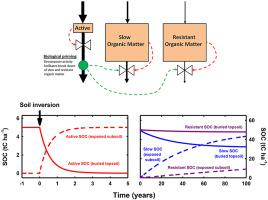Soil Biology and Biochemistry ( IF 9.8 ) Pub Date : 2021-09-23 , DOI: 10.1016/j.soilbio.2021.108432 Miko U.F. Kirschbaum 1 , Axel Don 2 , Michael H. Beare 3 , Mike J. Hedley 4 , Roberto Calvelo Pereira 4 , Denis Curtin 3 , Sam R. McNally 3 , Erin J. Lawrence-Smith 3

|
Subsoil carbon is generally older and decomposes more slowly than topsoil carbon. It has, therefore, been suggested that carbon stocks could be increased by burying carbon-rich topsoil at depth to slow its decomposition. This has been supported by recent experiments that showed that buried topsoil carbon indeed decomposed more slowly, but the mechanisms causing the reduction have not yet been identified. We investigated three theoretical mechanisms that may explain reduced decomposition rates at depth: (1) lower soil-temperature variability, (2) lower oxygen concentrations/redox potential and (3) less priming (biological synergy). Temperature variability decreases with soil depth. As decomposition rates vary non-linearly with temperature, reduced temperature variability should, therefore, reduce annual decomposition rates. However, detailed simulations showed that it changed annual decomposition rates by only a few percent. Maximal decomposition rates also require adequate oxygen, but our simulations showed that oxygen diffusion rates would need to be reduced 1000 to 10 000-fold compared to the topsoil for it to protect buried soil carbon. Oxygen limitation is, therefore, likely to be confined to soils that are water-logged for extended periods. Priming (or biological synergy) is assumed to be the stimulation of decomposition rates by the availability of labile organic carbon. Our simulations showed that lower labile carbon inputs could reduce priming and potentially preserve up to half of buried carbon for centuries. If experimental work can further substantiate the role of this mechanism, carbon burial at depth could become a practical and useful climate-change mitigation option.
中文翻译:

通过将土壤埋藏在剖面深处来固存土壤碳:三种可能机制的理论探索
底土碳通常比表土碳更老,分解更慢。因此,有人建议可以通过将富含碳的表土深埋以减缓其分解来增加碳储量。最近的实验表明,埋藏的表土碳确实分解得更慢,但尚未确定导致减少的机制。我们研究了三种可能解释深度分解率降低的理论机制:(1)较低的土壤温度变异性,(2)较低的氧浓度/氧化还原电位和(3)较少的引发(生物协同作用)。温度变异性随土壤深度而降低。由于分解率随温度呈非线性变化,因此降低的温度变化应该会降低年分解率。然而,详细的模拟表明,它只改变了年分解率的几个百分点。最大分解速率也需要足够的氧气,但我们的模拟表明,与表土相比,氧气扩散速率需要降低 1000 到 10000 倍,才能保护埋藏土壤中的碳。因此,氧气限制可能仅限于长期浸水的土壤。启动(或生物协同作用)被认为是由不稳定有机碳的可用性刺激分解率。我们的模拟表明,较低的不稳定碳输入可以减少启动,并有可能在几个世纪内保留多达一半的埋藏碳。如果实验工作可以进一步证实这种机制的作用,











































 京公网安备 11010802027423号
京公网安备 11010802027423号